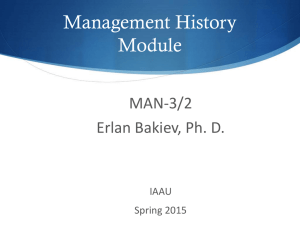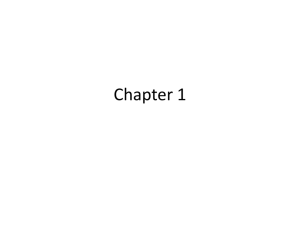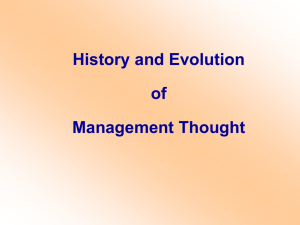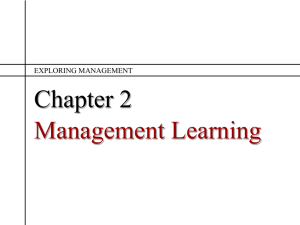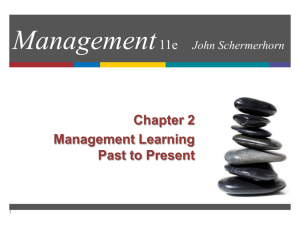Human relations
advertisement
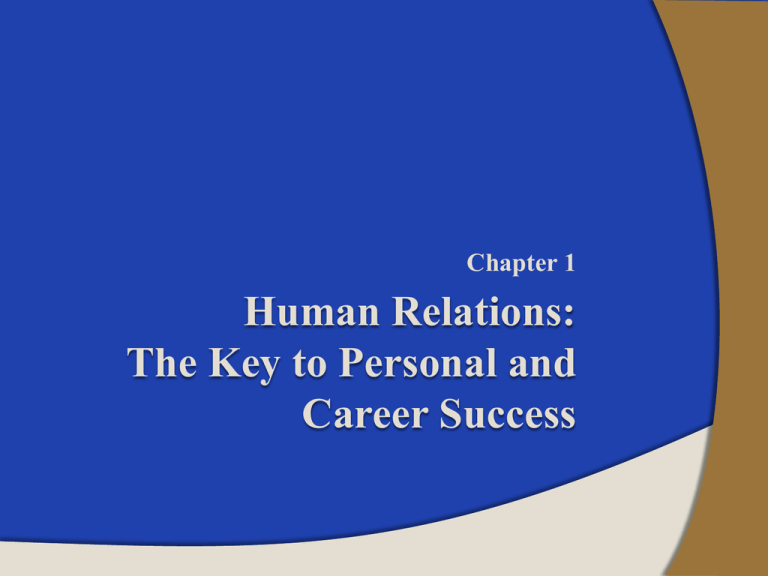
Chapter 1 Human Relations: The Key to Personal and Career Success Chapter 1 Objectives • Explain the meaning of human relations. • Discuss the importance of human relations to organizations and careers. • Trace the development of human relations in business. • Discuss 21st century competencies and your responsibilities in a 21st century organization. • Explain which outside forces can affect organizations. Chapter 1 Human Relations: The Key to Personal and Career Success 2 What Is Human Relations? Human Relations Defined • Human relations is the study of relationships among people. What Human Relations Is Not • Knowing what human relations isn’t is as important to your success as knowing what it is. Chapter 1 Human Relations: The Key to Personal and Career Success 3 What Is Human Relations? (cont.) A Systems Approach to Studying Human Relations • A system is a set of interrelated elements or parts that function as a whole. • In a system, all parts are connected to all other parts and are affected by at least one other part, and each part affects the whole. Chapter 1 Human Relations: The Key to Personal and Career Success 4 Figure 1.1 Human Relations and Organizational Productivity External factors Individual Factors in the organization Group Factors in the job Manager Chapter 1 Human Relations: The Key to Personal and Career Success 5 Why Is Human Relations Important? Importance of Human Relations to Organizations • Human relations leads to more productive organizations. • Organizations need people who can cooperate, collaborate, and produce results by working together. Chapter 1 Human Relations: The Key to Personal and Career Success 6 Why Is Human Relations Important? (cont.) Importance of Human Relations to Your Career • Effective human relations skills may be the greatest contributor to the success or failure of your career. • Understanding human relations gives you insight into how and why people think and act as they do. Chapter 1 Human Relations: The Key to Personal and Career Success 7 Why Is Human Relations Important? (cont.) Where Human Relations Starts • Building human relations skills starts with understanding your own mental and emotional makeup and your effect on others. • Knowing yourself, your values, and your principles will help you understand others, practice effective human relations, and achieve your goals. Chapter 1 Human Relations: The Key to Personal and Career Success 8 Development of Human Relations • Over time, several distinct and important schools of thought on human relations have evolved: Classical school of management Behavioral school of management Management science school of management Chapter 1 Human Relations: The Key to Personal and Career Success 9 Development of Human Relations (cont.) Classical School of Management (1900–1920s) • Focused on efficiency • Two branches of this theory: scientific management theory and classical organization theory • Scientific management theory: Frederick W. Taylor Frank and Lillian Gilbreth • Classical organization theory: Henry Fayol Chapter 1 Human Relations: The Key to Personal and Career Success 10 Development of Human Relations (cont.) Behavioral School of Management (1920s–1950s) • Two branches of this theory: human relations approach and behavioral science approach • Human relations approach: Elton Mayo Hawthorne studies Researchers realized that productivity increased because the workers were receiving attention—known as the Hawthorne effect Chapter 1 Human Relations: The Key to Personal and Career Success 11 Development of Human Relations (cont.) Behavioral School of Management (cont.) • Behavioral science approach: Scientific methods were used to explore efficient management techniques. Studies included both workers and managers and used psychology, sociology, and anthropology to understand the organizational environment. Chapter 1 Human Relations: The Key to Personal and Career Success 12 Development of Human Relations (cont.) Management Science School of Management (1960s–1990s) • Developed during World War II to solve complex problems of coordinating troops and supplies. • Techniques were developed with the help of mathematicians, physicists, and other scientists. • Development of the computer made statistical models easier to use. Models are analytical tools that help managers make decisions and plan and control organizational activities. Chapter 1 Human Relations: The Key to Personal and Career Success 13 Development of Human Relations (cont.) Information Age and Creative Age (1990s–Present) • Partnership for 21st Century Skills concludes: “. . . the industry economy based on manufacturing has shifted to a service economy driven by information, knowledge, and innovation.” • The U.S. is now entering the creative age when collaboration and creativity will be essential. Chapter 1 Human Relations: The Key to Personal and Career Success 14 21st Century Skills and Responsibilities • 21st century skills core subjects: English/reading/language arts World languages Arts Mathematics and science Geography and history Government/civics/ economics Chapter 1 Human Relations: The Key to Personal and Career Success • Skills to increase employability and effectiveness: Learning and innovation skills Information, media, and technology skills Life and career skills 15 Figure 1.4 21st Century Skills Learning and Innovation Skills Information, Media and Technology Skills Life and Career Skills Creativity and innovation Information literacy Flexibility and adaptability Critical thinking and problem solving Media literacy Initiative and self-direction Communication and collaboration Information and communications technology literacy Social and cross-cultural skills Productivity and accountability Chapter 1 Human Relations: The Key to Personal and Career Success 16 Outside Forces at Work • All organizations are vulnerable to a number of outside forces. • The frequency of changes within organizations requires that employees be open to change if they are to survive and thrive. Chapter 1 Human Relations: The Key to Personal and Career Success 17 Outside Forces at Work (cont.) Types of External Forces • Competition (locally, nationally, and internationally) • Globalization • Economic events (recessions) • Legal-political events (increase in taxes, political unrest) • Macro concerns (going “green”) Chapter 1 Human Relations: The Key to Personal and Career Success 18 Outside Forces at Work (cont.) Types of External Forces (cont.) • Mergers and management changes • Socio-cultural events (demographic shifts) • Unexpected natural disasters or acts of terrorism • Changing technology Chapter 1 Human Relations: The Key to Personal and Career Success 19 Outside Forces at Work (cont.) Examples of Two External Forces and Their Impacts • Organizational mergers: Organizations merge in an attempt to remain viable or to compete globally. Mergers offer a challenge for both employees and the organization. Employees suffer increased job insecurity and stress. One of the main causes leading to failure of mergers is the neglect of “key human element issues.” Chapter 1 Human Relations: The Key to Personal and Career Success 20 Outside Forces at Work (cont.) Examples of External Forces and Their Impacts (cont.) • Technology changes: Organizations are adding technologies that can have a profound impact on them and their employees. Computers substitute for workers who perform routine tasks, but they complement workers who perform nonroutine problem solving. Employees may need to embrace new management styles, new office processes, and maybe even new organizational structures. Chapter 1 Human Relations: The Key to Personal and Career Success 21 Outside Forces at Work (cont.) Examples of External Forces and Their Impacts (cont.) • Technology changes (cont.): Increased computerization creates tasks that require problem solving and communications skills. Employers need workers with expert thinking and complex communications skills. Technology makes possible different ways of working: ○ The virtual office ○ Telecommuters ○ Hoteling Chapter 1 Human Relations: The Key to Personal and Career Success 22 Outside Forces at Work (cont.) • Drawbacks to increased use of technology: Slower professional advancement Increased worker isolation Deteriorating social skills Effect on human brain of heavy use of digital technology Loss of face-to-face communication Internet security concerns and time-wasting Chapter 1 Human Relations: The Key to Personal and Career Success 23 Key Terms • Human relations • Management science • System • Classical school of • management • Behavioral school of management • Hawthorne effect • Chapter 1 Human Relations: The Key to Personal and Career Success • • school of management Statistical models Virtual office Telecommuters Hoteling 24
